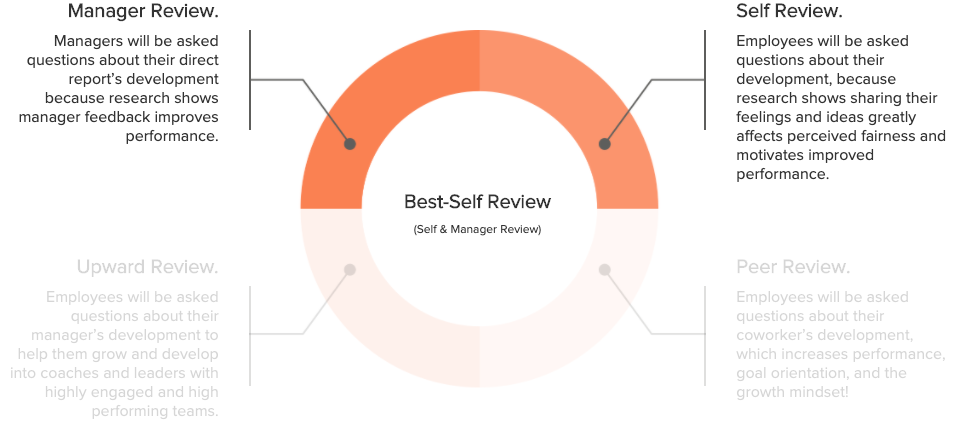The Science of 15Five: Best-Self Review
Best-Self Review Benefits to Managers
– Objectively assess employee performance by reducing recency bias
– Easily gather feedback and ensure direct reports continue to grow and develop
– Discover team members who are struggling and need additional support
Best-Self Review Benefits to Team Members
– Frequent growth and development conversations
– Reflect on your top strengths
– Identify growth opportunities to focus on

According to research by Deloitte, around 70% of companies are now reconsidering their performance management strategy. Many companies are simply renegotiating their relationship to the practice, keeping what works and removing what doesn’t. 15Five supports companies that are making the shift from an annual review process to more continuous feedback through multiple solutions based on specific company needs. For more frequent development conversations, we offer a Best-Self Review, which includes a Self and Manager Review, as well as a 360° Best-Self Review, which includes Self, Manager, Peer, and Upward Reviews.
Below we’ll dig into the academic research behind the key features in the Best-Self Review, which includes the Self and Manager Review, as well as the research behind each question in 15Five’s Recommended Question Template. We’ll also discuss the importance of the in-person conversation as well as hot topics in performance management such as how to assess performance and deal with compensation.
THE BEST-SELF REVIEW
Self & Manager Review
In the Self Review, employees will be asked questions about their own development. We include a Self Review for fairness because research shows active participation has a large effect on perceived fairness and motivation to improve, specifically for the sake of having one’s voice heard (sharing their feelings and ideas) rather than for the purpose of influencing the end result.
In a Manager Review, managers will be asked questions about their direct report’s development. We include a Manager Review for performance because research shows the Manager Review (external sources of evaluation) are more powerful than the Self Review for improving performance. However, as noted above, self assessment is key for perceived fairness and feeling heard. Both of these reviews are required for all Best-Self Reviews.
Job Description
Clear expectations are the most basic and fundamental employee need, so we intentionally begin the Best-Self Review with an employees job description. Multiple lines of research point to role clarity as a key driver for psychological safety, and effective check-ins and performance management practices.
According to Gallup, only 50% of employees clearly know what is expected of them at work. Yet, clarity of expectations is statistically linked to many important organizational outcomes. When this figure rises to 80%, organizations experience a 14% reduction in turnover and a 7% increase in productivity. Including a job description ensures that expectations are clear and that managers and employees are on the same page about their employees main responsibilities. 81% of reporters who use 15Five say they’re clearer about their role, Objectives, and impact on their organization.
Growth & Development [15Five’s Recommended Question Template]
We recommend that when completing the Self and Manager Review, managers and employees answer the same Growth and Development questions for consistency and fairness. Managers and employees can use “Resources for your reviews,” which includes past Objectives and 15Five’s to reference past performance data when answering these questions. This process reduces recency bias and ensures a more objective and fair assessment of performance and development feedback.
Company Values
The Best-Self Review is a development conversation that goes beyond just performance and paints a more robust picture of each team member, including how employees live out their company values. Human beings can’t be reduced to a single number. Instead, the Best-Self Review helps managers find the most complete view of a person.
Objectively Assessing Performance: The Private Manager Assessment & Objective Performance Measures
After completing the Growth and Development section, managers will also have the option to complete the Private Manager Assessment. The Private Manager Assessment includes future focused questions inspired by research from Deloitte and highlighted in the April 2015 HBR article, Reinventing Performance Management, by Marcus Buckingham and Ashley Goodall. These questions are designed to reduce cognitive biases and help managers objectively assess performance.
Research shows that humans are biased and poor at developing accurate and objective assessments of performance. In fact, most assessments of performance, especially in the form of ratings, reveal more about the rater than the actual performance of the person being rated. In other words, if I rate someone, 62% of my rating is a reflection of me and only 21% of my rating accounts for actual performance. This is called the idiosyncratic rater bias.
Although we rate other people’s skills inconsistently, we are highly consistent when rating our own feelings and intentions. Therefore, to reduce the idiosyncratic rater bias, our Deloitte inspired questions ask managers what they would do with each team member rather than what they think of that individual.
Resources For Your Reviews
During the Self and Manager Review, managers and employees can view their Objectives and past 15Five’s in the ‘Resources for your reviews’ Section. This reduces recency bias and ensures a more objective and fair assessment of performance and feedback. According to Gallup, only 29% of employees strongly agree that the performance reviews they receive are fair, and only 26% strongly agree they are accurate.
15Five solves this problem and ensures that managers and employees objectively keep track of performance throughout the year. Employees complete the 15Five Check-in every week, so when quarterly or semi-annual reviews come around, all of their progress over time lives in one place. In 15Five, managers have months of data like completion percentages on OKRs for an unbiased and accurate view of performance. Setting and monitoring goals throughout the year helps ensure performance feedback is frequent, timely, and remains as objective as possible. Research shows that when managers keep track of key performance milestones and projects, the quality of their feedback improves.
If you’re interested in learning more about the rest of the 360° Best-Self Review, including the research behind Peer and Upward feedback, please go back to the 360° Best-Self Review webpage.
THE BEST-SELF CONVERSATION
The Most Important Part
The in-person conversation is the most important part of the Best-Self Review. We recommend managers keep it light, get out of the office, and go outside or take a walk to chat with their team members about their growth and development. Most importantly, team members should know where they stand at all times through the continuous feedback given in their Weekly Check-in and 1-on-1s so come review time, there should be no surprises!
Managers can use the Best-Self Review template (strengths, wins, development areas, and impact focus) as a guide during the conversation. We also recommend managers complete reviews on time and check in with their employees after their in-person conversation to see whether they thought the process was fair and useful. Research shows this simple post review follow-up is an important step to increase perceived fairness and the likelihood for a successful review process.
ADDRESSING RATINGS AND RANKINGS
Why We Removed Them and What We Use Instead
Research shows forced rankings and ratings generate negative employee reactions, create a culture of unhealthy competition, and are perceived as unfair. In short, they reduce collaboration and motivation, so like many other companies, we stand against them. The Best-Self Review is a development conversation, one that’s separate from the pay conversation. Although it’s important to separate pay and development, in both conversations, managers and employees need to objectively keep track of performance throughout the year. We create a safe space for honest feedback and reflection by decoupling development conversations from compensation discussions, while still providing the data necessary to make important decisions.
In order to help managers objectively assess employee performance, we created the Private Manager Assessment (for more details, see the section above: Objectively Assessing Performance). Managers should use the Weekly Check-in for continuous feedback and can use the Private Manager Assessment in the quarterly or semi-annual Best-Self Review to objectively assess performance. In a separate, but timely pay conversation, managers can then look back at the Private Manager Assessment data, to guide their compensation discussion and decision.
ADDRESSING COMPENSATION
How Pay Fits Into The Best-Self Review and Overall Motivation Strategy
We can’t talk about reviews without talking about compensation and rewards, and we can’t talk about rewards without talking about motivation. According to Dan Pink, New York Times bestselling author, the truth about what motivates us is surprising. Traditionally money was thought to be the best way to motivate. And even today, leaders try to motivate through financial incentives and external rewards such as pay for performance plans and bonuses. Pink calls this motivating via ‘carrots and sticks’. However, contrary to what many think, science shows that carrots and sticks actually decrease motivation and can lead to poorer performance!
Instead, building on the research from professors Richard Ryan and Edward Deci, Pink shows that we can increase employee engagement and performance via internal motivators such as autonomy (our desire to be self directed), mastery (our urge to get better at stuff), relatedness (feeling a sense of belonging and connection to others) and purpose (making a contribution or putting a useful ding in the universe).
With a better understanding of what motivates, we have a basis for being strategic about rewarding employees. According to Pink, money should only be used as a motivator by paying people enough to take the issue of compensation off the table. If you don’t pay people enough, they won’t be motivated. Leading management thinker and author, Alan Colquitt says that to reduce the carrots and sticks mentality we need to replace traditional pay for performance programs and bonus plans with strong base pay at or above market rate and other organization and team-based incentives like stock option plans. So, first ensure fair pay at market rate and then motivate high performance through internal motivators and continual growth and development.
Additionally, when we talk about Objectives in relation to Reviews, the most common question we hear is whether goal completions should be linked to promotions and pay increases. If goals are high stretch goals, don’t link them to pay. Research shows extremely high goals combined with economic incentives lead to unethical behavior, since tying rewards to goal achievement can create a “results at all costs” mentality. Google is known for setting overly ambitious objectives, and many companies have followed suit. Other organizations use a different strategy by having teams and employees set more attainable objectives and use OKRs as a method for goal tracking. Success will then be benchmarked by 90-100% completion, rather than 60-70%. We know that every company is different, so in 15Five, companies can customize Objectives to be stretch goals or not.
We recommend that companies decouple stretch Objectives from pay decisions, and when assessing performance for compensation decisions, to use the Private Manager Assessment and triage those answers with as many objective measures as possible, including both behaviors and results. Separate pay and development conversations, ensure you’re paying market rate, and communicate your compensation philosophy to your employees early and often so everyone is aligned and clear from the start. Overall, Objectives should be used for establishing direction and setting a context for work that motivates employees by linking their efforts to company priorities, thereby imbuing high leverage tasks with greater purpose and meaning.
15Five’s Best-Self Review places employees on a full-fledged growth trajectory toward their best self, helping companies achieve both high performance while bringing out the best in their people. We are building a world where employees and managers are excited about their next review. And instead of feeling judged and graded, employees walk away from their conversation feeling inspired and developed.




